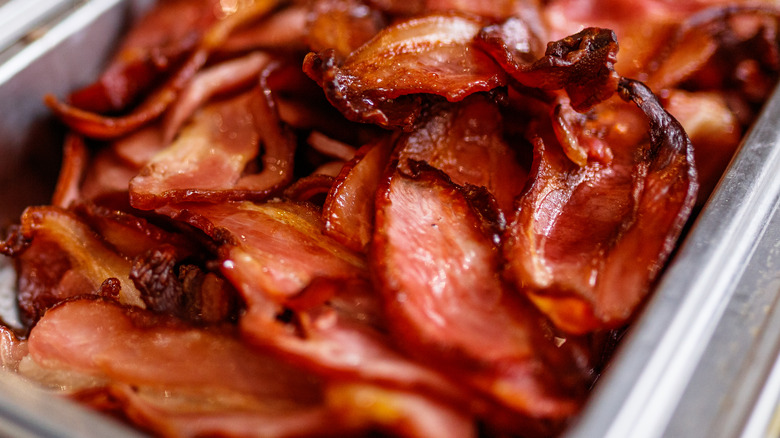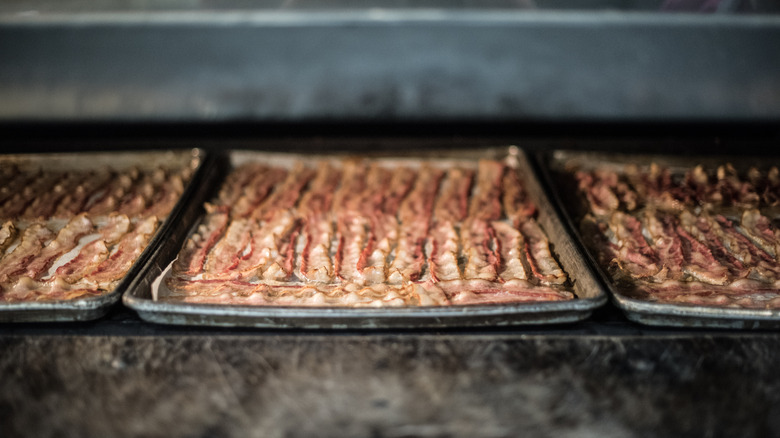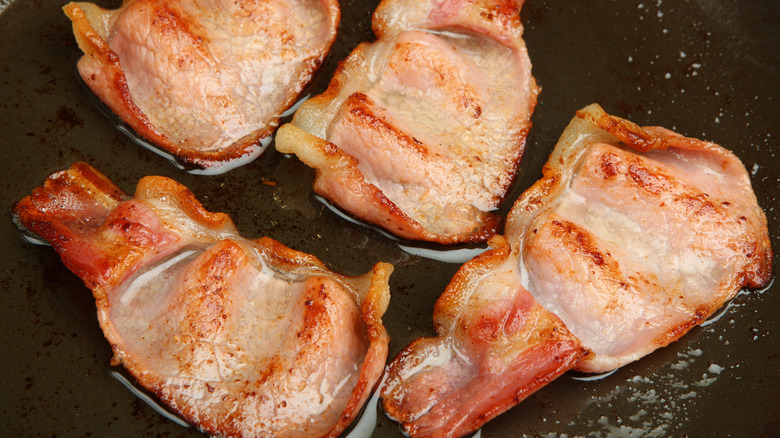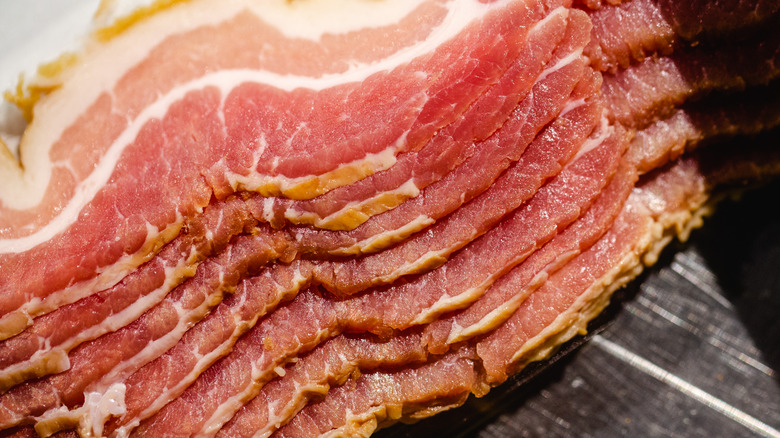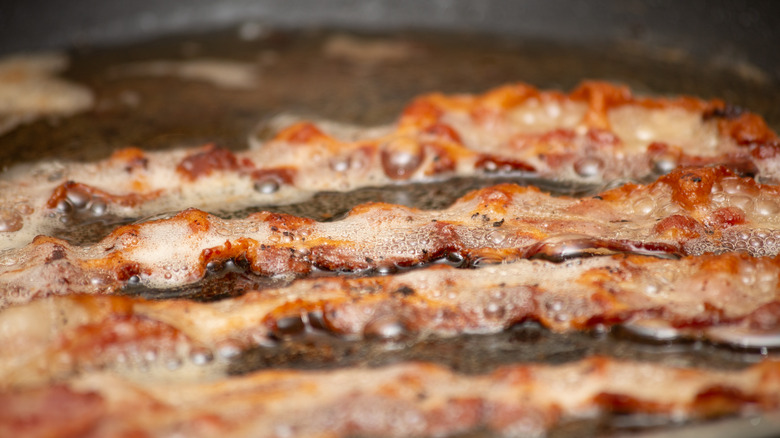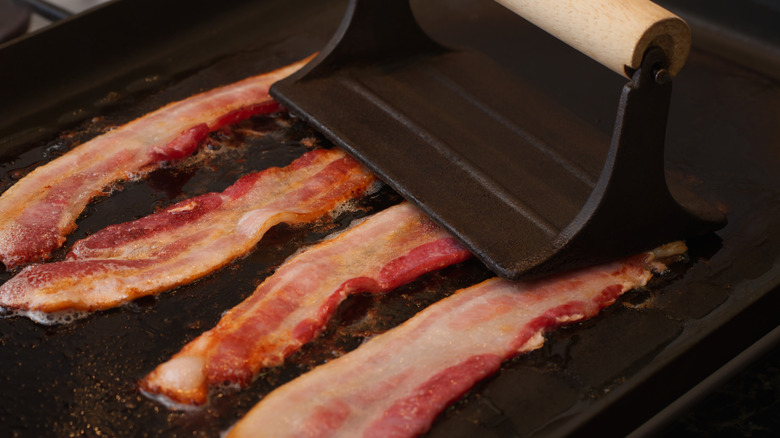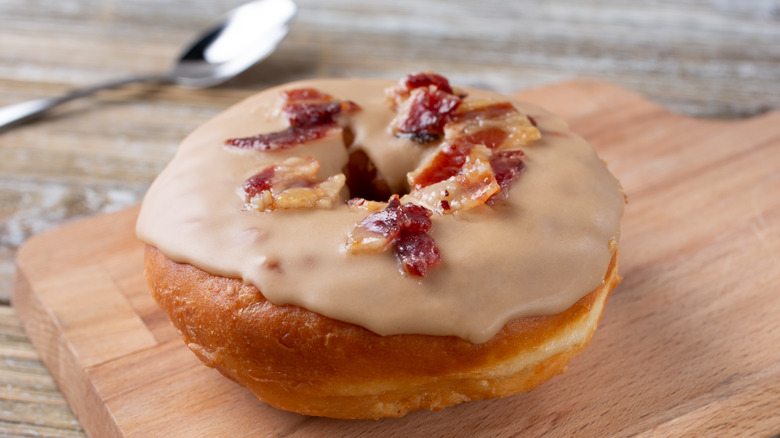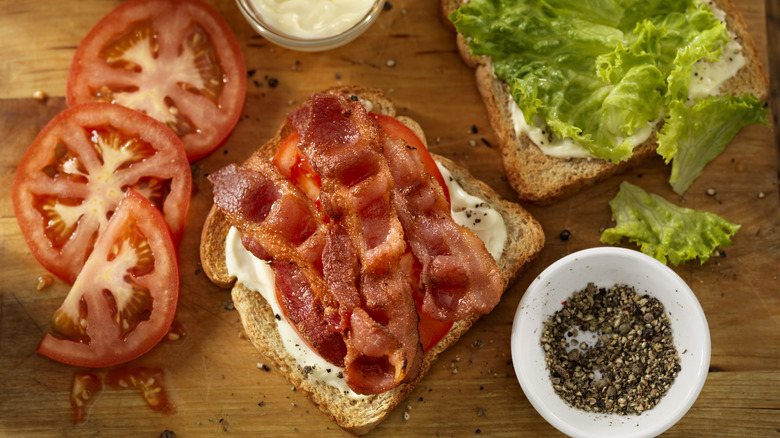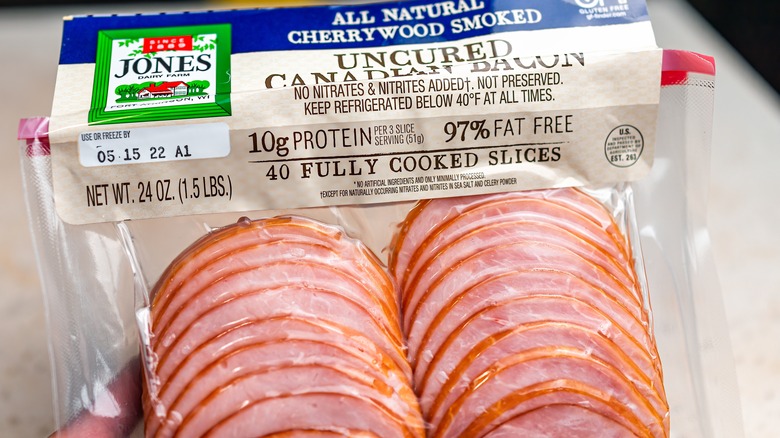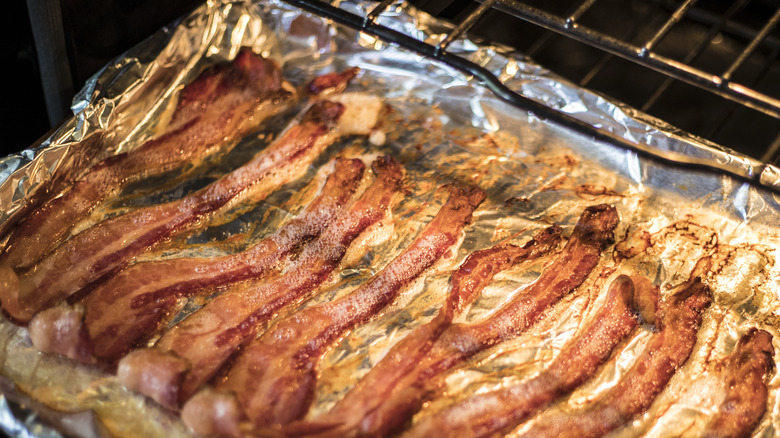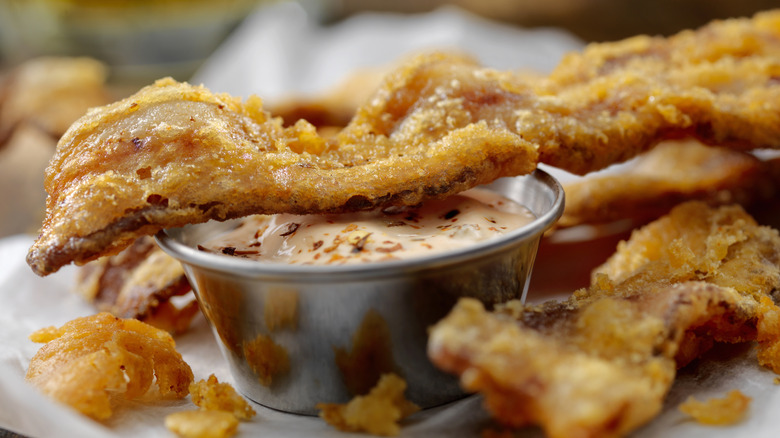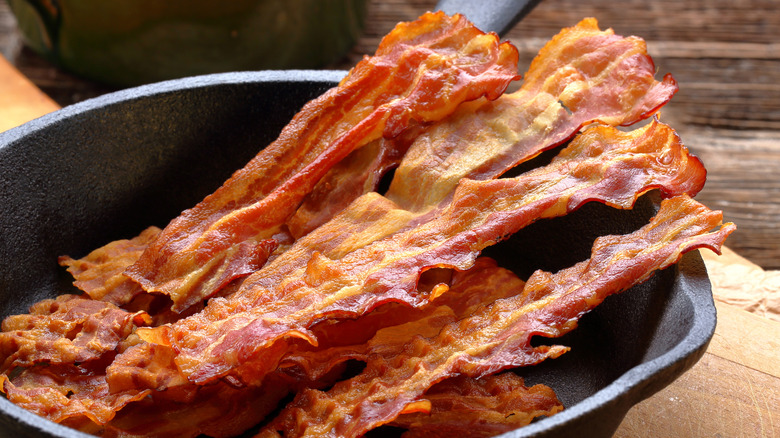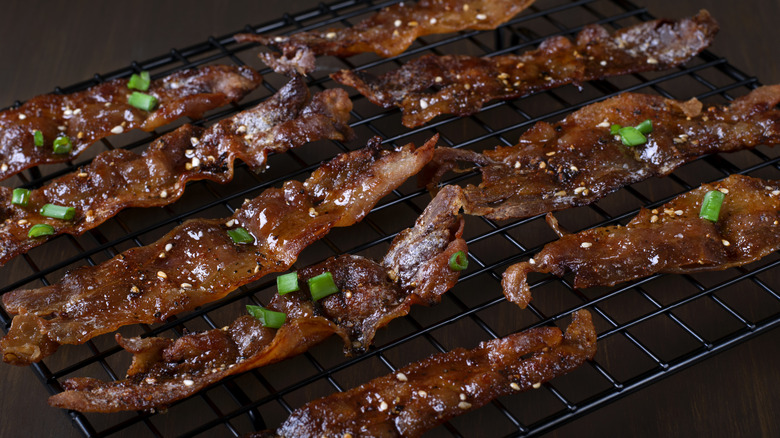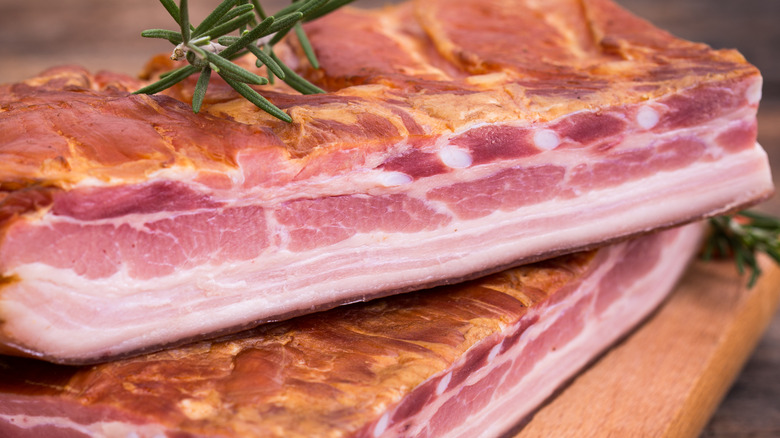Why Bacon Tastes Better At A Restaurant
If you love bacon but feel it's somewhat of a guilty pleasure, then rest assured that you're not alone. With six umami flavor boosts unlocked in those salty slices, it's no surprise that bacon is so moreish. It's why there are so many bacon recipes, from a grilled barbecue bacon bison burger to cheesy bacon breakfast pizza. Restaurant menus entice with bacon dishes served as appetizers and main courses, and even desserts and drinks!
From a mom-and-pop style eatery to a greasy-spoon diner or fancy bistro bacon tastes better at a restaurant quite often. Of course, food often tastes good if someone else is cooking it for you and using culinary skills you don't possess. However, the reason why chefs know how to cook with bacon so well is because they use special techniques to get the right texture and create flat slices. They also know what cuts to use, when, and how to add bacon to recipes in creative and classic ways.
It is par-broiled to fry crispier
Have you ever grabbed a few bacon strips early in the morning at a hotel buffet and been impressed by how the chefs have made them taste so darned good? Not only are they cooked evenly and browned nicely, but they promise just the right balance of crispiness without disintegrating into bits when you bite into them. And aside from that, you might have wondered if they have wall-to-wall frying pans sizzling away to produce such a high turnover of hot slices. If you think there might be a pro chef hack happening here, you'd be right. There's a fantastic technique that many restaurant cooks use that makes hot, crispy bacon strips fast.
Chefs often par-broil bacon in lots of oil first to lock in moisture and then keep these slices cold until an order comes in. When they want to serve it, the oil-soaked, half-cooked bacon fries in a flash in a skillet. The rashers stay flat rather than curl and contract. If bacon is cooked to order, the chef can fry it to be super-crispy and brittle or keep some limpness and just char the edges. Before fully cooking, a chef might refrigerate the slices with kitchen towels to soak up any excess fat.
Restaurants use different bacon cuts
Trained chefs have the culinary know-how to choose the right cuts of bacon for certain dishes. This is undoubtedly one reason bacon tastes better at a restaurant. At home, you might use the same pack of bacon whether you're making a sandwich or the ultimate bacon-wrapped chicken bomb. Streaky bacon, with a high-fat content, is added to breakfast plates as it turns wonderfully crispy. However, Brits often fry back bacon, which is leaner and comes from the loin. Canadian bacon is similar to this, although the taste and texture are far more ham-like. A rasher of bacon in the U.K. includes the loin and belly meat, so it's lean and meaty tasting bacon and deliciously crispy in the same slice.
Uncut smoky bacon comes from the belly, and this makes it fatty when it's cooked. Italian bacon, or pancetta, is smoked so that you can eat it raw, which gives it a soft, oily texture and smoky taste. If you're used to buying classic American bacon strips, you might want to explore different cuts of meat so that you can enjoy bacon as you do at a restaurant.
Quality bacon is sourced and cooked staightaway
If you've ever bought a pricey pack of bacon, perhaps because it's cut extra-thick or smoked using special ingredients, you've no doubt tasted the difference compared to a budget pack. However, busy restaurant chefs are not spending their time sauntering around farmers' markets or butchers selecting bacon from small producers in this way. So why is it that bacon tastes better at a restaurant so often?
Cooking techniques play a big part, but so too does the quality of the bacon. Buying in bulk doesn't mean that the standard of the meat is compromised. Chefs have the contacts to source a good supplier they can trust, and it doesn't matter if that supplier is a large-scale provider. What also makes a big difference is that the turnover of produce is so quick that the bacon used in restaurants is often super fresh, especially when compared to bacon packs you pick up in the store. Restaurant cooks know what texture, odor, and appearance to look for when buying bacon and can find the exact thickness and fat content they want.
Bacon is cooked in water
You can no doubt come up with a few ways restaurant chefs cook bacon. These undoubtedly include slapping a few rashers on a hot grill beside some steaks. You may have seen busy diners laying slices down next to hash browns and eggs on a griddle. And then there's broiling, roasting, and, of course, frying in oil. Good chefs can achieve bacon slices that have a nice crispness to them without being dried out or burnt. One way some of these culinary pros do this is by cooking bacon in water. It's not as strange as it first sounds.
If you'd like to give it a go, add bacon rashers to a skillet and cover with water. Bring this to a boil and simmer on a lower heat. As the water evaporates, the fat will render without the slices burning and losing a softer texture when you bite into them. Turn the heat down once again as the bacon sizzles in what's left of the water in the pan. This method ensures that the bacon doesn't break up or turn into the texture of shoe leather. You get succulent bacon that's also got some crunch.
Some restaurants use a grill press
It's a busy morning, and you're trying to juggle making a cooked breakfast with all the upcoming demands of the day. You throw a few rashers onto a griddle or into a skillet, and as they hit the hot oil, they immediately shrink as they start to cook. If the oil is too hot, you might see a white scum-like substance forming in the pan as the water is forced out of the meat. Another issue is that bacon can curl up, making it challenging to cook it evenly. If you've ever bitten into a rasher that's burnt to a crisp on one part and somewhat limp and rubbery at the same time, then you'll know how unappetizing this can be. The trick that chefs understand is that you need to keep bacon flat. But how?
One way is to use a grill press. Pressing down on bacon rashers means they get a nice, even color and cook evenly. Made of cast iron traditionally, a press also ensures that no heat is lost. It's not just about taste; depending on whether slices are served with a full breakfast or part of another dish, the flatness looks more appetizing and restaurant-like. You can also use a bacon press in a cast iron skillet.
Creative bacon dishes are made
If you had to name a few bacon dishes off the bat, would a maple-glazed donut with crunchy bacon bits come to mind? Possibly not. Bacon is such a loved ingredient by chefs and diners alike that it's being added to dishes in truly creative ways. And it's not just meals either. Bacon has made its way onto cocktail and drink menus. Look out for mixologists adding candied bacon as a garnish, such as an Old Fashioned with a peppered bacon rasher, or serving up bacon-infused bourbon on the rocks.
Interesting bacon dishes that restaurants have made include cooked bacon dipped in melted chocolate that's then hardened and served cold. There's even been gold-dusted bacon served atop a Wagyu burger with truffle cheese served up in Vegas. Where else? Or what about caramel and bacon-bits popcorn for an alternative salty-sweet snack? Have you ever tried crumbling blue cheese on thick bacon rashers or adding bacon and cheese as a donut filling? There's no doubt that bacon jam has become an increasingly popular condiment paired with all types of delicious dishes such as burgers or, in its own right, with cheese melted on top and crusty bread to dip in. Then there's bacon ketchup and bacon butter as well.
It's used for classic dishes
How do you eat bacon at home? Do you sizzle up a few rashers and serve them with a stack of pancakes? Brits love nothing better at the weekend than a bacon sandwich or bacon butty, as it's called. Bacon tastes better at a restaurant quite often because it's served in classic dishes that everyone knows and loves. Bacon is given a mighty flavor boost when paired with ingredients that make the taste really stand out.
A great example is a BLT, which you probably know is a bacon, lettuce, and tomato sandwich. Bacon is the star of this brunch winner, but that's because the crispness of the lettuce, the juiciness of the sliced tomatoes, and the creamy mayo complement the meat. You might have also tried a BLAT when eating out, which is a BLT with avocado added.
While different eateries serve club sandwiches in various ways, bacon is the gold standard ingredient. Whatever deli meats or types of cheese are added, there's no missing out on the bacon. There's something so satisfying about a bacon and chicken club for lunch. Plenty of diners love a couple of crispy strips atop a chargrilled burger while serving bacon with liver, onions, and mashed potato is a must on many menus. And who doesn't love a bacon-wrapped sausage canapé or devil on horseback with a fruity date inside?
Healthier bacon choices are on the menu
One of the attractions of eating out at a good restaurant is eating quality ingredients prepared by a skilled chef. This can certainly be the case if cooks source specific types of bacon. If you've ever eaten at a low-end diner and been served what tastes like watery, rubbery bacon with white bits stuck to the meat, it could be that the product is not that great. Chefs may choose to cook dishes using uncured bacon, for example, as it's not made using additives such as nitrates and sodium phosphates. Sugar can be added to bacon during the curing process, too.
Other significant differences include whether bacon is free of hormones, which links to animal welfare issues. Sustainability is a guiding culinary force for plenty of restaurants and head chefs and may be noted in the description of a dish, too. Knowing where produce comes from has been an increasing trend among diners who want to know exactly what they are eating and whether meat contains antibiotics, additives, and preservatives. While you can buy organic bacon for cooking at home, restaurants can seek out certain producers and serve up bacon that's often healthier. Just knowing that bacon is being sourced responsibly can make a restaurant dish taste even better. After all, food is about feeling good, too.
Restaurants cook rashers in the oven
You might not mind a few oil splatters when you cook bacon for a Sunday morning fry-up. However, this isn't the most practical way to go about whipping up lots of rashers simultaneously for busy restaurants with a breakfast menu or hotel buffets. A quick, mess-free way is to cook the slices in the oven instead. That way, chefs can serve up a whole tray full of sizzling pieces at the same time.
There are a few different ways to cook bacon in the oven, including putting the meat directly on the rack and catching the fat in a tray underneath. This stops the bacon from cooking in too much grease and produces a drier, crispier result. The other method is to arrange the bacon directly on top of a lined baking tray using greaseproof paper or foil. To get straight slices, some hotels add the bacon to a tray lined with baking paper and then lay another sheet on top and press down. A wire rack is put on top to keep the top baking sheet in place. This way, the bacon stays flat and cooks evenly. A simpler way is to fill a lined baking tray with bacon, cook in a preheated oven, and drain the bacon fat once the rashers are cooked. Of course, a good chef will save that flavorful fat for making other dishes.
Sometimes bacon is deep-fried
Does deep-fried bacon sound ridiculously decadent? Make no mistake, it is, but it's also so dastardly delicious. One of the quickest ways to cook food is to plunge it into hot oil. With lots of bacon to prep for hungry appetites in the morning, some restaurants cook the slices this way. This method can make bacon instantly tougher but not crumbly, giving it a chewier texture, which some people love.
What's definitely a thing, for sure, is deep-fried bacon in batter or chicken fried bacon as it's called. It first appeared on a menu in Texas as an appetizer at Sodolak's Original Country Inn in the '90s, having been created by the eponymous owner, Frank Sodolak. Crunchy batter transforms any dish, and there are plenty of tips on creating a crispier coating. A great way to bubble up the outside so that it's super snackable is to use a beer batter. The bubbles in the ale react with the oil, making the coating light and airy. Imagine biting into some crispy bacon inside and dipping the strips in some meaty or creamy gravy or enjoying them with Sriracha-mayo. The crispy slices look great stacked up on a plate, too, and grabbing a strip and dipping it means this is an ideal dish to share.
Thin slices are used
Have you ever noticed how crispy and easy to eat the slices are when you're chowing down on a crispy bacon rasher at a diner or a hotel breakfast buffet? What makes them so moreish compared to the bacon you cook at home? You can literally lift up the light rashers with your hands and eat them without a knife and fork, like candy. The secret about why bacon tastes better at a restaurant often is not just whether the bacon is cured or uncured, smoked or unsmoked, but also the thickness of the slice.
At home, the bacon you buy at the store is often medium-cut. In an inch, you might get 16 slices, which is ideal for covering bread slices to make grilled cheese for bacon lovers. Chefs might opt for thinner slices with 32 pieces per inch. The thinness of the meat means it cooks quickly and crisps up more easily. Dense bacon can take time to cook through, and then there's always the chance it may burn in the process. But it's good to use for pasta dishes or sandwiches with bacon when looking for a meatier taste rather than crispiness. For certain recipes like these, a chef may use a thicker slice, with eight slices per inch.
Bacon is glazed
Bacon is spectacularly scrummy, but what's great about chefs is that they can turn a crispy, salty rasher into a sweet, spicy delight. The best way to turn these meaty slices into snacks that go beyond bacon is with a glaze. Restaurant chain First Watch is renowned for its Million Dollar Bacon. The recipe isn't so complex, but the taste of glazed bacon is terrific. This dish is made with hardwood smoked rashers baked in the oven with maple syrup, black pepper, cayenne, and brown sugar. As the sweet ingredients caramelize, the salty bacon crisps up, and the spices elevate the taste.
There's so much scope for different glazes, added ingredients, and garnishes. Fresh herbs and sesame seeds on bacon with a dark, sweet-and-salty glaze can give the slices an Asian flavor. Thicker bacon is more suited to glazing, so the flavors balance and cook evenly. Cooking the bacon in the oven on a rack allows the heat to get underneath the meat, too, so there's no need to flip halfway through. Bacon that's basted every few minutes as it cooks can be turned into deliciously chewy candied bacon with a simple maple syrup glaze made with brown sugar, black pepper, and rice vinegar.
Some restaurants make their own bacon
Most restaurants don't make their own in-house bacon, but those that do no doubt promote the fact. Homemade bacon on a menu is definitely a reason why a dish will taste better. Bacon can be smoked once or double-smoked using a variety of wood chips from maple to applewood, mesquite, hickory, and cherry. A dry or wet cure can be used, and how these are applied and how long the meat is smoked for is a fine culinary art. Other ingredients also go into the process, with different types of salt, sugar, and spices. Each producer creates a unique flavor, and the color of the bacon often differs, too.
There are also different cuts used, depending on what dish is being created. Skilled chefs can learn the techniques to smoke bacon using high-quality equipment and sourcing pork that will produce the best bacon. Pro cooks understand how herbs and spices complement produce, which means they can add a little heat and herby notes to their bacon, too. Maple syrup can also be added to the mix to make the slices a little sweet. Restaurant chefs who put passion into their culinary efforts at every stage create bacon dishes that wow diners.
